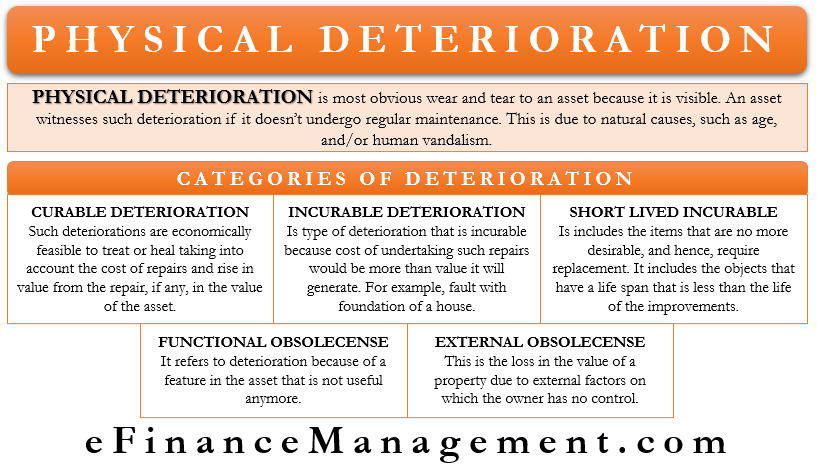What is Physical Deterioration?
Physical deterioration is the most obvious wear and tear to an asset because it is visible. An asset witnesses such deterioration if it doesn’t undergo regular maintenance. Or its maintenance is unable to keep pace with the physical wear and tear of the asset. For instance, a new car will start looking old a few years later if the maintenance is not up to the mark.
In simple words, we can say that it is the loss in the value of an asset due to natural causes, age, usage, or human intervention. The natural causes can be rain, termites, dust, earthquakes, flood, etc. And the human cause could be fire, neglect, breakdown, and more.
Understanding such deterioration is useful for determining depreciation.
Physical Deterioration – Are they Curable?
On paper or in theory, every type of physical deterioration is curable. But, it is better to leave some deterioration as it is due to practical reasons. For instance, if there is an issue with the foundation of the house. It will be costly to repair it.
A point to note is that physical deterioration does not mean obsolescence. So, it is possible to make good most forms of physical deterioration. For example, suppose the paint on your house starts looking old. You can always cure this deterioration by re-painting your house. Some of the common forms of physical deterioration that are curable are – loose or faulty wiring, repairs, water-proofing, paint, construction material, loose tiles, and more.
The intensity of the deterioration that an asset goes through depends on the maintenance and the original quality of the asset. For instance, a house that uses good quality construction materials is likely to survive deterioration better than a house built with low-quality construction materials. Also, a house that goes through regular maintenance work, such as painting, repairing, etc., witnesses lower deterioration.
Categories of Physical Deterioration
There are primarily two types of such deterioration:
Curable Deterioration
Such deteriorations are economically feasible to treat or heal. Deterioration is economically feasible to treat if the rise in the value of the asset (after repair) is more or equal to the cost of repairing. To determine if curing the deterioration is economically feasible or not, one needs to estimate the cost of repairs. Also, one needs to estimate the rise in value from the repair, if any, in the asset’s value.
For example, the roof of a house suffers damage due to an earthquake. The bill to repair the roof is $5,000. Going for this repair is feasible because repairing it would definitely increase the value of the house.
Incurable Deterioration
As the name suggests, it is the type of deterioration that is incurable. This means the cost of undertaking such repairs would be more than the value it will generate. Thus, such deteriorations are not economically feasible to undertake. For example, a fault is with the foundation of a house. To repair it, one has to rebuild the house from scratch. In all such cases, usually, the cost of curing or repairing the asset always remains very high compared to the final value of that asset after the repair. In other words, the value adds to the asset remains less the cost it would need to repair.

Short-lived Incurable Physical Deterioration
This is a sub-category of incurable deterioration. It includes the items that are no longer desirable and require replacement. Or this category includes the objects with a life span that is less than the life of the improvements. Such a category includes the objects that wear and tear faster than the maintenance work.
For example, an electric chimney gets undesirable after a few years because new, more efficient chimneys are available in the market. If the old chimney is in working condition, it may not be cost-effective to replace it with a new one. Over time, when this chimney gets really old, it would get economically feasible to replace it rather than repair it and increase life for a short period.
Some, however, believe that the short-lived physical deterioration is curable. They argue that such deterioration will eventually get fixed (means replaced).
Other Forms of Deterioration
An asset may witness other types of deterioration as well, in addition to the physical deterioration. These are
Functional Obsolescence
Functional obsolescence refers to deterioration because of a feature in the asset that is not useful anymore. The presence of that feature results in a drop in the asset’s worth. Similarly, deterioration can be due to the absence of a particular feature in the asset. Such deterioration could be due to a change in technology, change in preferences, and more. For example, an old multi-story building has no elevator, which is a must in the current time. Note that such obsolescence is healable if the repair price is less than the value it brings. For example, there are no fire extinguishers and fire hydrants in a multi-story building. However, these facilities are easy to be installed, and definitely, the cost is also less as compared to the value adds it will offer to the building.
External Obsolescence
This is the loss in the property’s value due to external factors over which the owner has no control. External factors could be a new governmental policy, changes in traffic, environmental limitations, and more. We can also say that these are the factors that result in the loss in the value of a property with no fault of the owner. For example, the government decides to construct a jail in the locality. The property value in such a case would go down.

